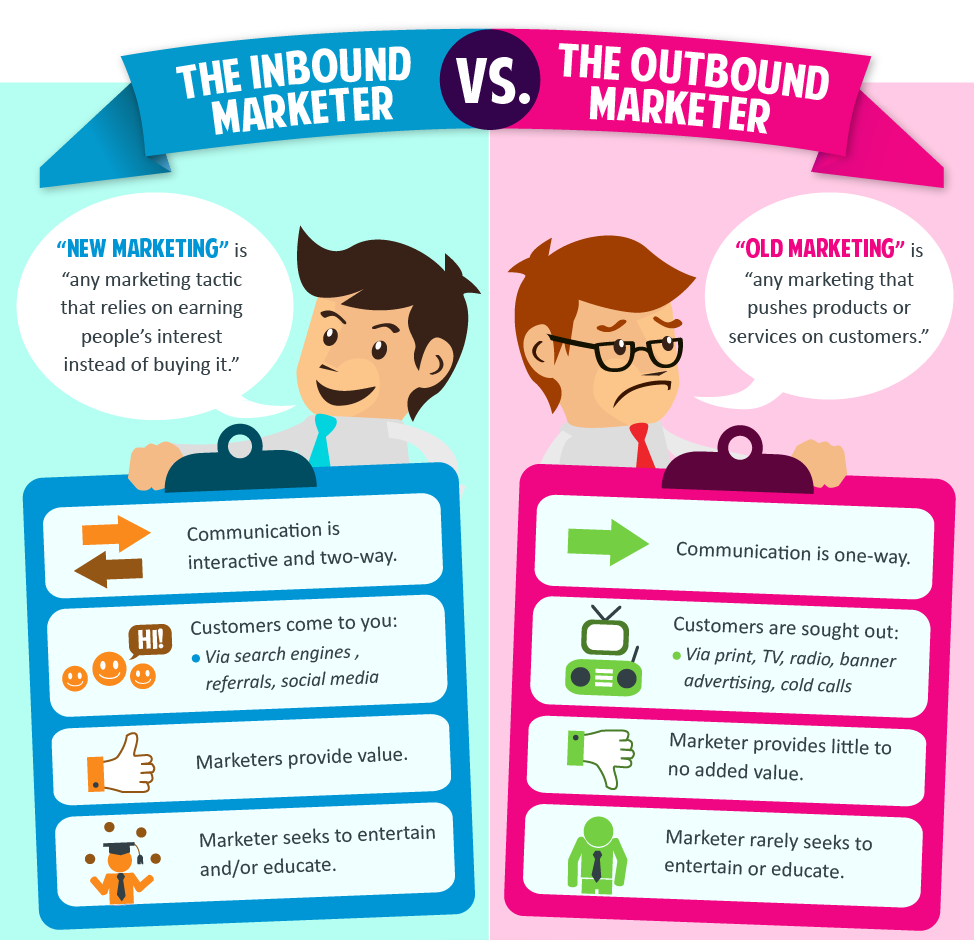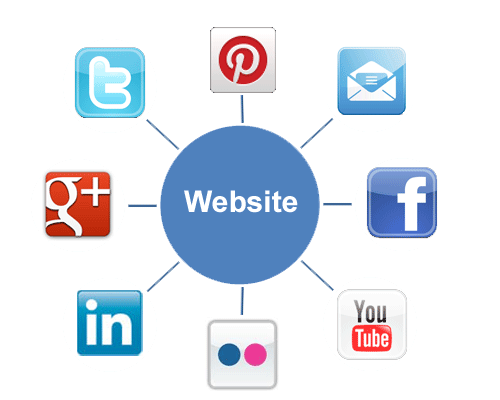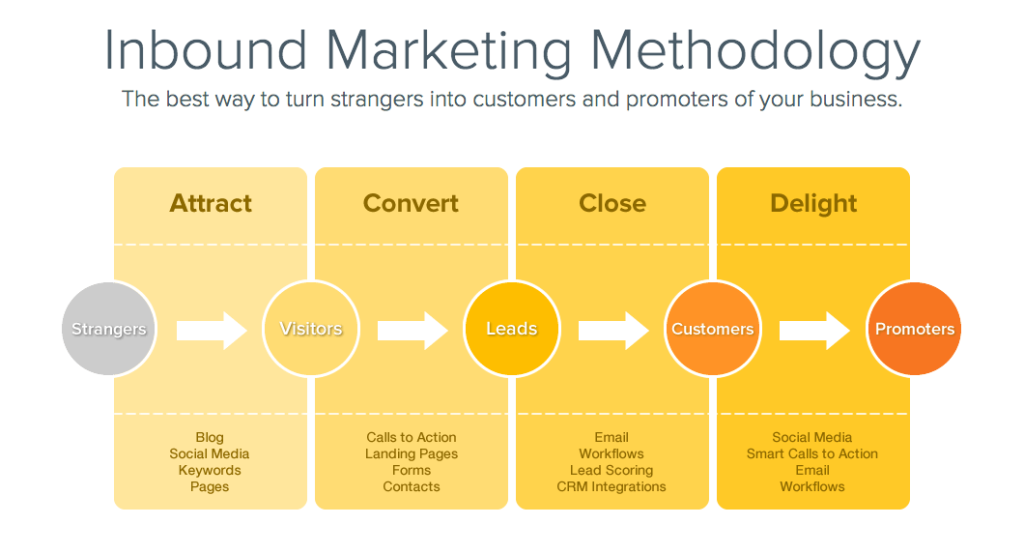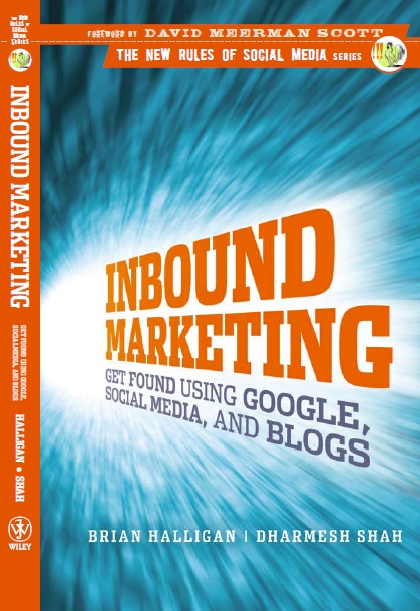
Do you know what Inbound Marketing is? Keen to use inbound marketing to improve your marketing ROI?
Pioneered by co-founders of HubSpot Brian Halligan and Dharmesh Shah, inbound marketing is a leading Business to Business (B2B) digital marketing strategy. The fact that HubSpot is a NASDAQ listed marketing automation company worth $1.24 billion in market capitalisation is a testimony to inbound marketing’s strengths.
Written by Halligan and Shah, Inbound Marketing covers the fundamentals of inbound marketing, and how one can “get found using Google, Social Media and Blogs.”
Spanning the breadth of using content to generate leads, acquire prospects and convert customers, the book straddles content marketing, Search Engine Optimization (SEO), social media and other related areas.
What is Inbound Marketing?
First, let us define what inbound marketing is. Here’s the best definition of inbound marketing:
Inbound marketing is an online marketing strategy focused on marketing activities and content that draw visitors in, as opposed to marketers going out to reach potential customers. It involves making the company and its brands easily found by attracting prospects with interesting and relevant content on websites, apps, and other channels.”
Traditionally, marketers use outbound marketing techniques like email blasts, telemarketing, direct mail, TV ads, trade-shows, radio and print advertisements to reach buyers. Unlike outbound methods, inbound marketing looks at using targeted and valuable content on the Internet to draw customers in.
Inbound marketing is permission based, while outbound marketing interrupts. Key differences between inbound and outbound marketing is nicely summarised in the infographic below (source of image):
Creating a Marketing Hub
The first step in inbound marketing lies in creating a marketing hub. An inbound marketing hub is a web site that with a blog, offers useful and compelling content, and is connected to “spokes” like email, sales conferences, social media sites (Facebook, Twitter, LinkedIn, Instagram, TikTok, YouTube), social discovery platforms (Reddit, Digg, Delicious), and others.
Content is shared either directly on the website itself, or accessed through RSS feeds. Often such a website would have thousands of links coming from other websites. It should also be graded with tools like a Website Grader.
This can be represented by the diagram below (source of image):
Content and Inbound Marketing
Great content forms the core of inbound marketing. In fact, content marketing is viewed as a subset of inbound marketing.
To succeed, companies need to build a content factory and operate like media/content companies (eg Wikipedia, New York Times, Mashable, etc). They should create remarkable content which provides great utility, attract links from other websites, and rank well on search engines.
Examples of such content (primarily B2B focused) include:
- Blog articles – the mainstay of content and inbound marketers
- White papers – five to seven page papers that educate marketplace on trends and challenges
- eBooks – Long form online PDFs that provide an easy guide for marketers
- Videos – instructional and educational videos about the industry
- Webinars – online presentations on an industry topic
- Podcasts – audio programmes often featuring interviews with experts
- Webcasts – Live videos viewed online
Google Searches and Social Media
In order for your marketing hub to be found, you need to rank well on search engines (like Google) and be shareable on social media. Let us go through each in turn.
a) SEO in a Nutshell
The book gives a brief but useful run down of Search Engine Optimization (SEO), educating readers on the difference between Pay Per Click (PPC) ads like Google Ads and organic content on the Search Engine Results Page (SERP). Key areas covered include:
- Finding perfect keywords through balancing relevance, search volume and difficulty (ie competition)
- On-page SEO: page titles, meta description tags, URLs, domain names, headings, and images
- Off-page SEO: Generating inbound links through creating and sharing remarkable content
- Avoiding Black Hat SEO practices like using link farms, automated content duplication, keyword stuffing, hidden texts, and others
b) Social Media Marketing
From Facebook pages, Twitter accounts, LinkedIn profiles to YouTube videos, the book teaches readers how they should set up their social media accounts and “socialize” their content through these platforms. Best practices in using social discovery sites like reddit and StumbleUpon (a toolbar allowing you to vote for websites) are also covered.
The following words of advice from FreshBooks (featured in the book) are probably worth considering:
- Tell your story on social media
- Participate – follow up quickly to comments and comment on other accounts
- Be open and treat people like you would like to be treated
- Listen
- Social media is a commitment, not a campaign
Inbound Marketing Funnel
The most iconic element of inbound marketing is the ubiquitous marketing or sales funnel. Through a careful and calibrated process, the book leads readers through the funneling process of converting visitors or prospects into leads, and leads into customers.
This process can be best summarized by the sales funnel created by HubSpot itself (courtesy of HubSpot):
Here, there are three key things to take note of:
a) Calls To Action (CTAs)
First, you should have several Calls-To-Action (CTAs) on your website, with different types of forms. This can be anything from requests for demos, downloading of white papers, meeting requests and so on. Generally speaking, the best CTAs follow the acronym VEPA, ie they are…
- Valuable – Provide valuable and helpful information to help users do their job better (eg webinars, white papers, e-book, research studies, free consultations)
- Easy to Use – Make it easy and fuss-free to act on
- Prominent – Ensure that it is prominently placed and unmistakable, with a clickable image and large font (minimal clutter)
- Action Oriented – Use a verb and tell visitor what action to take (eg “Get Your ____ Grade”, or “Free Consultation”)
b) Landing Page and Form
The landing page is the final step in converting a visitor to a lead. Well-designed landing pages can convert up to 50 percent of its visitors, while a poor ones convert less than one percent.
A good landing page matches content on the landing page with the content on the call-to-action (be it on the Google Ad, Facebook post, or email), builds trust with professional design and well-written copy, serves one function, and is simple and easy to fill.
Forms on landing pages should likewise have minimal inputs (usually just name and email address at the first stage), be seen above the fold (ie readers don’t have to scroll down), be simple, and instill trust.
c) Tracking
Lastly, it is important to track the progress of each conversion stage, be it stranger to visitors, visitors to leads, leads to customers, and customers to promoters (advocates). Through web analytics software, you should be able to track indicators like web traffic, sign ups (at each stage), click throughs for CTAs, and more.
Managing Inbound Marketing
Finally, successfully inbound marketing is predicated on three steps:
a) Hire right people and measure them right
Here, we’re told to hire DARC employees, ie
- Digital Citizens (people familiar with the web)
- Strong in Analytics (quants familiar with analysis)
- Possess Web Reach (ie influencers who already have a following)
- Content creators (talents that can write like ex-journalists, shoot amazing photos or produce stirring videos)
Talents should then be measured on the four qualities above, graded accordingly, and compensated based on their performance on these variables.
b) Pick right PR agency
Ensure that the PR agency you work with has the chops to execute inbound marketing. They should have digital citizens savvy with search and social, possess a decent website (as measured though a website grader), and have experience helping clients in inbound marketing.
c) Watch competition
Inbound marketers should be paranoid about competition and keep tabs on how they are doing. There are seven ways to do so:
- Website Grade – Run your website alongside competitors’ web sites on Website.Grader.com
- Delicious – Check how well your competitors pages are bookmarked
- Inbound Links – Check for the number of links for you and your competitors
- Twitter Grade – Go to Twitter.Grader.com to compare
- Facebook fans – Check for the number of Facebook fans you have vis-a-vis your competitor
- Compete – Go to Compete.com to compare estimate of traffic of your site versus competitors
- Buzz – Go to Google and do a search on “your brand” versus “your competitor brand” (in quotations)
ABCs of Inbound Marketing
Part of the New Rules of Social Media series, Inbound Marketing is an essential guide to B2B marketers keen to embrace inbound and content marketing. Although the book was first published in 2009, its principles are still valid to this day and age.
Admittedly, inbound marketing is still pretty nascent here in Asia. The majority of B2B companies are still investing a lot more time and effort in doing cold calls, participating in trade shows, and pitching their value proposition in terms of price-performance as opposed to customer value. Hopefully though this may change over time.
Inbound Marketing co-authors Dharmesh Shah and Brian Halligan (courtesy of HubSpot)





